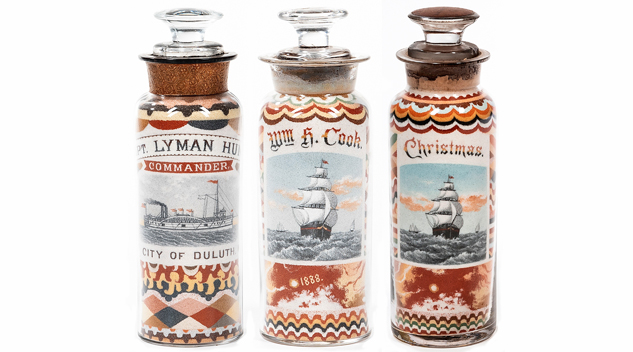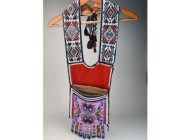MARLBOROUGH, MASS. — Skinner’s “timed” Americana sale included three sand bottles made by Andrew Clemens in the late Nineteenth Century, which collectively grossed $1,798,750. As rare as these works are, it’s unusual to find three in one auction, and, interestingly, they came from three different consignors. Clemens was born in Dubuque, Iowa, in 1857. At the age of five he became deaf and mute after an illness. He later earned his livelihood by painstakingly arranging colored sand to make pictures in glass bottles. If you haven’t seen one of these sand bottles, it’s worth going out of your way to do so. How they were made will mystify you.
The sand came from the naturally colored sandstone river bluffs near his home in Iowa. He worked in McGregor, Iowa, and for a short time he made the pictures and exhibited his work at a South State Street dime museum in Chicago. The most highly sought-after examples are those with the most detailed scenes, and those that were made-to-order as presentation pieces. Strong interest in this art form is relatively recent. When a bottle first appeared in an episode of The Antiques Roadshow in 2002, it was valued at between $4,000 and $6,000. One of the bottles in this sale depicted an Irish red and white setter on one side with the word “Christmas” above a fully rigged sailing vessel on the other side. It sold for $852,500. There is a printed maker’s label affixed to the top, which is inscribed “Pictured Rock Sands Put up by A. Clemens, Deaf Mute, McGregor, Iowa.” An indistinct label on the bottom has the name of the dog.
Perhaps the same bidder bought another of the three. It had a banner reading, “Capt. Lyman Hunt, Commander, City of Duluth” on one side of the bottle and depicted the paddlewheel steamer City of Duluth. The other side showed an urn of flowers, wavy lines and abstract and geometric bands. Hunt was captain of the Duluth from about 1880 to 1888. It descended in the Hunt family, for whom the bottle was made. Skinner had a thick folder with details concerning Lyman Hunt and the steamer, including vintage photographs of the ship. It brought the same amount as the previous example, $852,500.
The third bottle had a banner on one side with the name “Wm H. Cook” and portrayed the sailing vessel Wm H. Cook with two smaller distant vessels. It was dated 1888 and the reverse depicted an eagle in flight with an American flag. It sold for $93,750.
Prices given include the buyer’s premium as stated by the auction house. For information, www.skinnerinc.com or 508-970-3200.





